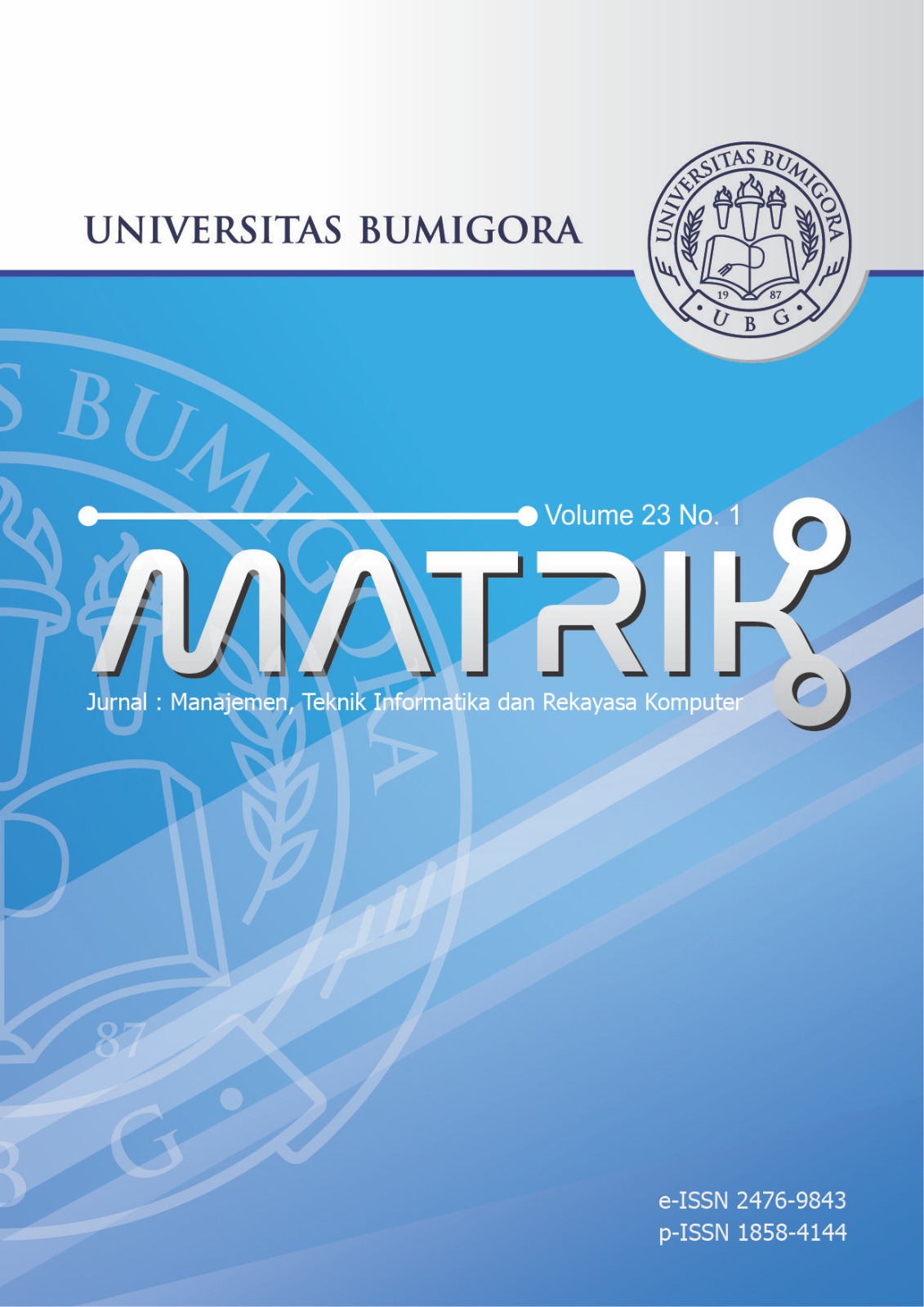Implementing K-Nearest Neighbor to Classify Wild Plant Leaf as a Medicinal Plants
Abstract
in leaf shape. Therefore, this study aimed to create a system to help increase public knowledge about wild plant leaves that also function as medicinal plants by the KNN method. Leaves of wild plants, namely Rumput Minjangan, Sambung Rambat, Rambusa, Brotowali, and Zehneria japonica, are also medicinal plants in comparison. Image processing techniques used were preprocessing, image segmentation, and morphological feature extraction. Preprocessing consists of scaling and splitting the RGB components and using an RGB component decomposition process to find the color component that best describes the leaf shape and generate the blue component image. The segmentation process used a thresholding technique with a gray threshold value (T) of less than 150, which best separates objects and backgrounds. Some morphological feature extraction used are area, perimeter, metric, eccentricity, and aspect ratio. Based on the results of this research, the KNN method with variations in K values, namely 13, 15, and 17, obtained a system accuracy of 94.44% with a total of 90% training data and 10% test data. This comparison also affected the increase in system accuracy.
Downloads
References
vol. 7, no. 2, pp. 18–20, 2019.
[2] B. Sun, L. Wu, Y. Wu, C. Zhang, L. Qin, M. Hayashi, M. Kudo, M. Gao, and T. Liu, “Therapeutic Potential of Centella asiatica
and Its Triterpenes: A Review,” Frontiers in Pharmacology, vol. 11, no. September, pp. 1–24, 2020.
[3] I. M. S. Harsa, “Efek Pemberian Ekstrak Daun Pegagan (Centella Asiatica) Terhadap Penyembuhan Luka Sayat Pada Tikus
Putih Jantan (Rattus Norvegicus) Galur Wistar,” Jurnal Ilmiah Kedokteran Wijaya Kusuma, vol. 9, no. 1, pp. 21–27, 2020.
[4] C. A. Mareta, “Efektifitas Pegagan (Centella Asiatica) Sebagai Antioksidan,” Jurnal Medika Hutama, vol. 02, no. 01, pp.
402–406, 2020.
[5] D. Eka, K. Sari, T. Widowati, and N. Atika, “Kelayakan Daun Pegagan ( Centella Asiatica ( L .) Urban) Sebagai Bahan Dasar
Sabun Untuk Kulit Kering,” Beauty and Beauty Health Education Journal, vol. 12, no. 2, pp. 78–85, 2023.
[6] R. I. Borman, R. Napianto, N. Nugroho, D. Pasha, Y. Rahmanto, and Y. E. Pratama Yudoutomo, “Implementation of PCA and
KNN Algorithms in the Classification of Indonesian Medicinal Plants,” in 2021 International Conference on Computer Science,
Information Technology, and Electrical Engineering (ICOMITEE), oct 2021, pp. 46–50.
[7] K. Saputra and S.Wahyuni, “Identifikasi Jenis Tanaman Berdasarkan Ekstraksi Fitur Morfologi Daun Menggunakan K-Nearest
Neighbor,” Jurnal Teknik dan Informatika, vol. 5, no. 1, pp. 24–29, 2018.
[8] S. A. Rosiva Srg, M. Zarlis, and W. Wanayumini, “Identifikasi Citra Daun dengan GLCM (Gray Level Co-Occurence) dan
K-NN (K-Nearest Neighbor),” MATRIK : Jurnal Manajemen, Teknik Informatika dan Rekayasa Komputer, vol. 21, no. 2, pp.
477–488, 2022.
[9] R. H. Ariesdianto, Z. E. Fitri, A. Madjid, and A. M. Imron, Nanda, “Identifikasi Penyakit Daun Jeruk Siam Menggunakan
K-Nearest Neighbor,” Jurnal Ilmu Komputer dan Informatika (JIKI), vol. 1, no. 2, pp. 133–140, 2021.
[10] L. N. Sahenda, A. A. Ubaidillah, Z. E. Fitri, A. Madjid, and A. M. N. Imron, “Application of Feature Selection for Identification
of Cucumber Leaf Diseases (Cucumis sativa L.),” JISA (Jurnal Informatika dan Sains), vol. 04, no. 02, pp. 173–178, 2021.
[11] B. A. Prasetya, Z. E. Fitri, A. Madjid, and A. M. N. Imron, “Ensiklopedia Digital Varietas Ubi Jalar Berdasarkan Klasifikasi
Citra Daun Menggunakan KNearest Neighbor,” Elektrika, vol. 14, no. 1, pp. 1–6, 2022.
[12] N. E. Paulina, Z. E. Fitri, A. Madjid, and A. M. N. Imron, “Klasifikasi Kerusakan Mutu Tomat Berdasarkan Seleksi Fitur
Menggunakan K-Nearest Neighbor,” MIND (Multimedia Artificial Intelligent Networking Database) Journa, vol. 6, no. 2, pp.
144–154, 2021.
[13] M. J. Roldan, T. Chin, Y. Tsai, A. L. Castillo, and O. B. Villaflores, “Cytotoxic and Angiosuppressive Potentials of Zehneria
japonica (Thunb. ex Murray) S.K. Chen (Cucurbitaceae) Crude Leaf Extracts,” Philippine Journal of Health Research and
Development, vol. 22, no. 01, pp. 43–52, 2018.
[14] M. M. Sheam, Z. Haque, and Z. Nain, “Towards the antimicrobial, therapeutic and invasive properties of mikania micrantha
knuth: A brief overview,” Journal of Advanced Biotechnology and Experimental Therapeutics, vol. 3, no. 2, pp. 92–101, 2020.
[15] W. Wiharto, F. H. Nashrullah, E. Suryani, U. Salamah, N. P. T. Prakisya, and S. Setyawan, “Texture-Based Feature Extraction
using Gabor Filters to Detect Diseases of Tomato Leaves,” Revue d’Intelligence Artificielle, vol. 35, no. 4, pp. 331–339, 2021.
[16] P. Rosyani and S. Saprudin, “Deteksi Citra Bunga Menggunakan Analisis Segmentasi Fuzzy C-Means dan Otsu Threshold,”
MATRIK : Jurnal Manajemen, Teknik Informatika dan Rekayasa Komputer, vol. 20, no. 1, pp. 29–36, 2020.

This work is licensed under a Creative Commons Attribution-ShareAlike 4.0 International License.


.png)













